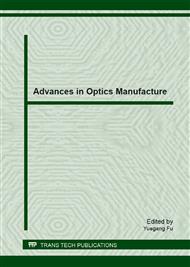[1]
DOCCHIO F, SACCHI C, MARSHALL J. Experimental investigation of optical breakdown thresholds in ocular media under single pulse irradiation with different pulse durations [J].Lasers Ophthalmol, Vol. 39-1 (1986), p.83
Google Scholar
[2]
MAZHUKIN V I , NOSSOV V V. Modeling of plasma dynamics at the air-water interface. Application to laser shock processing [J]. Journal of Applied Physics, Vol.90-2(2001), p.608.
DOI: 10.1063/1.1378061
Google Scholar
[3]
CHEN J, BIAN B, WANG Y. Laser-induced plasma shock wave and cavity on metal surface underwater[J]. Microwave and Optical Technology Letters, Vol.25-5 (2000), p.307.
DOI: 10.1002/(sici)1098-2760(20000605)25:5<307::aid-mop6>3.0.co;2-1
Google Scholar
[4]
BIAN Bao-min, CHEN Xiao, XIA Ming, et al. The investigation of laser-induced plasma shock wave propagation in liquids [J]Acta Physica Sinica Vol.53-2 (2004), p.508.
DOI: 10.7498/aps.53.508
Google Scholar
[5]
LI Ming, ZHANG Hong-chao, SHEN Zhong-hua, et al. Physical analyses of optical breakdown and plasma formation in water induced by laser[J].Acta Photonica Sinica, Vol.34-11 (2005), p.1610.
Google Scholar
[6]
FAN C H, SUN J P. Longtin Plasma Absorption of Femtosecond Laser Pulses in Dielectrics[J].Journal of Heat Transfer, Vol.42-2 (2002), p.224
DOI: 10.1115/1.1445135
Google Scholar
[7]
HUANG Wen-li, SUN Guang-sheng, YAN Ping , et al. Overview of Experimental Research on Breakdown in Liquid Dielectrics Under Nanosecond Pulse [J]. High Voltage Engineering, Vol. 32-4 (2006), p.73
Google Scholar
[8]
LI Sheng-yong; ZHU Qiang-hua; ZHAO Rui, et al. Properties of Laser-Induced Cavitation Bubble Sound Waves in Viscous Fluid[J].Acta Photonica Sinica, Vol.38-8 (2009), p.(2082)
Google Scholar
[9]
Xu Rong-qing, Chen Xiao , Shen Zhoung-hua, et al. Dynamics of laser-induced cavitation bubbles near solid boundaries [J].Acta Physica Sinica, Vol.53-5 (2004), p.1413
DOI: 10.7498/aps.53.1413
Google Scholar
[10]
L. Martí-Lópeza,b, R. Ocañaa, E. Piñeiroc, et al. Laser Peening Induced Shock Waves and Cavitation Bubbles in Water Studied by Optical Schlieren Visualization [J] Physics Procedia Vol.12 (2011), p.442
DOI: 10.1016/j.phpro.2011.03.055
Google Scholar


